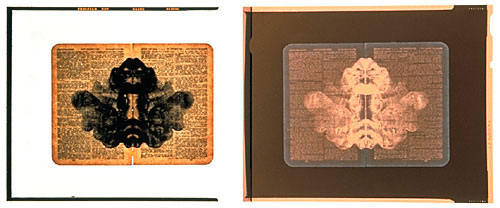- work •
- statement •
- reviews + essays •
- resume •
- contact
deankessmann
Rorschach Bible Pages
cibachrome prints, 9.5 x 21.5 inches, 1996
cibachrome prints,
9.5 x 21.5 inches,
1996
Read a short description of this project






















Rorschach Bible Pages
Most of us are familiar with the Rorschach (Ink Blot) test and its proposed purpose in psychological analysis. In this series of photographs the same question is asked—what do you see? Dogmatic doctrine or free choice; fact or fiction; objective reports or subjective interpretations; helpful advice or harmful instructions; personal expression or religious desecration; truthful information or biased propaganda; meaningful reiteration or simplified repetition. As this list implies, one approach to the interpretation of these images is to focus on the outermost limits of our acceptance or rejection of this holy text. These extremes, represented by the pieces of positive and negative film, which many people feel the need to choose between, are often manipulatively positioned as good and evil, or more pointedly in a religious context as heaven and hell. But is it necessary to confine oneself within either of these polarities? If we desire, we may choose to walk along the fine line between the two. This seemingly claustrophobic and finite space—in the images, the area where the two pieces of film converge and overlap—is actually a quiet reminder that even when competing forces collide there often exists points of infinite possibilities. If we want or expect an ancient passage or even yesterday’s newspaper to be relevant to our lives today, we all must take personal responsibility to analyze, and then carefully synthesize what is placed before us.